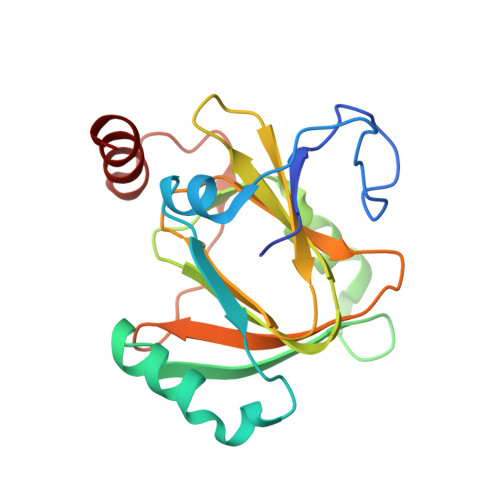On the Structure and Reaction Mechanism of Human Acireductone Dioxygenase.
Milaczewska, A., Kot, E., Amaya, J.A., Makris, T.M., Zajac, M., Korecki, J., Chumakov, A., Trzewik, B., Kedracka-Krok, S., Minor, W., Chruszcz, M., Borowski, T.(2018) Chemistry 24: 5225-5237
- PubMed: 29193386
- DOI: https://doi.org/10.1002/chem.201704617
- Primary Citation of Related Structures:
4QGN - PubMed Abstract:
Acireductone dioxygenase (ARD) is an intriguing enzyme from the methionine salvage pathway that is capable of catalysing two different oxidation reactions with the same substrate depending on the type of the metal ion in the active site. To date, the structural information regarding the ARD-acireductone complex is limited and possible reaction mechanisms are still under debate. The results of joint experimental and computational studies undertaken to advance knowledge about ARD are reported. The crystal structure of an ARD from Homo sapiens was determined with selenomethionine. EPR spectroscopy suggested that binding acireductone triggers one protein residue to dissociate from Fe 2+ , which allows NO (and presumably O 2 ) to bind directly to the metal. Mössbauer spectroscopic data (interpreted with the aid of DFT calculations) was consistent with bidentate binding of acireductone to Fe 2+ and concomitant dissociation of His88 from the metal. Major features of Fe vibrational spectra obtained for the native enzyme and upon addition of acireductone were reproduced by QM/MM calculations for the proposed models. A computational (QM/MM) study of the reaction mechanisms suggests that Fe 2+ promotes O-O bond homolysis, which elicits cleavage of the C1-C2 bond of the substrate. Higher M 3+ /M 2+ redox potentials of other divalent metals do not support this pathway, and instead the reaction proceeds similarly to the key reaction step in the quercetin 2,3-dioxygenase mechanism.
Organizational Affiliation:
Jerzy Haber Institute of Catalysis and Surface Chemistry, Polish Academy of Sciences, Niezapominajek 8, 30-239, Krakow, Poland.



















